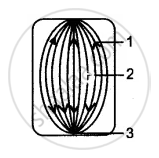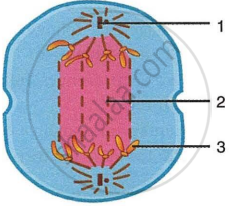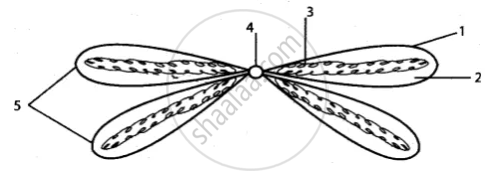Advertisements
Online Mock Tests
Chapters
2: Fundamentals of Genetics
3: Absorption by Roots
4: Transpiration
5: Photosynthesis
6: The Circulatory System
7: The Excretory System
8: The Nervous System and Sense Organs
9: The Endocrine System
10: The Reproductive System
11: Human Population
12: Physical Health and Hygiene
13: Pollution
![ICSE solutions for Biology [English] Class 10 chapter 1 - Cell Division ICSE solutions for Biology [English] Class 10 chapter 1 - Cell Division - Shaalaa.com](/images/biology-english-class-10_6:5f2b1b2038084cf381bfa42c826a928c.jpg)
Advertisements
Solutions for Chapter 1: Cell Division
Below listed, you can find solutions for Chapter 1 of CISCE ICSE for Biology [English] Class 10.
ICSE solutions for Biology [English] Class 10 1 Cell Division Short Questions
What is the direct cell division? Explain with an example.
Name the two kinds of cell division found in living organisms.
What type of cell division does occur in somatic cells of the body?
Where does the meiosis occur in our body?
What do you mean by cell-cycle?
Write the name of various steps of cell cycle.
Name the structure which initiates cell division?
Why gametes have a haploid number of chromosomes?
Mention three significant changes that occur in a cell during interphase.
What is cytokinesis?
How does colchicine act as mitotic poison? Is there any advantage of it?
Explain the significance of mitosis.
Why is meiosis referred to as reduction division?
What is the importance of meiosis in creating variations?
State how does meiosis maintains chromosome number in a species.
How prophase-I of meiosis differs from prophase of mitosis in an essential way? Describe how it affects the daughter cells?
What is the importance of chiasma formation?
What is the importance of meiosis?
ICSE solutions for Biology [English] Class 10 1 Cell Division Give Reasons
Give Reasons for the following
The mitosis is called equational division.
Give Reasons for the following
The meiosis is called reductional division
Give a reason for the following:
Gametes must be produced by meiosis for sexual reproduction.
Give Reasons for the following
Chromosomes are the carriers of heredity.
ICSE solutions for Biology [English] Class 10 1 Cell Division Differentiate
Differentiate between
Mitosis and Meiosis.
Differentiate between
Centrifugal cytokinesis and Centripetal cytokinesis.
Differentiate between
Chromatin and Chromosome.
Differentiate between
Anaphase of Mitosis and Anaphase of Meiosis-I.
Differentiate between
Gametic meiosis and Zygotic meiosis.
Differentiate between Cytokinesis and Karyokinesis.
Differentiate between
Chiasmata and crossing over.
Differentiate between
Cytokinesis in plant and animal cell
ICSE solutions for Biology [English] Class 10 1 Cell Division Diagram Based Questions
Identify the stages of mitosis given below and label the figures.
Identify the stages of meiosven below and label them.
The diagram below represents a certain stage of a cell.
(i) Is it an animal cell or a plant cell ? Give one reason in support of your answer.
(ii) Label the parts numbered 1 – 3.
(iii) Which stage (phase) of mitosis is represented in this diagram
(i) Draw a neat labeled diagram to show the metaphase stage of mitosis in an animal cell having ‘6’ chromosome.
(ii) How many daughter cells are formed at the end of mitosis and at the end of meiosis?
(iii) With reference to cell division explain the following terms:
(Chromatid, Centromere, Haploid).
(iv) Name the type of cell division that occurs during:
1. Growth of shoot 2. Formation of pollen grains.
3. Repair of worn out tissues.
The diagram below represents a stage during cell division. Study the same and then answer the questions that follow:

- Name the parts labelled 1, 2, and 3.
- Identify the above stage and give a reason to support your answer.
- Mention where in the body this type of cell division occurs.
- Name the stage prior to this stage and draw a diagram to represent the same.
In the given diagram name the parts labeled 1, 2, 3,4 and 5 and describe about them in short.
Given below is a diagram representing a stage during mitotic cell division. Study it carefully and answer the questions that follow:
(i) Is it a plant cell or an animal cell? Give a reason to support your answer.
(ii) Identify the stage shown.
(iii) Name the stage that follows the one shown here. How is that stage identified?
(iv) How will you differentiate between mitosis and meiosis on the basis of the chromosome number in the daughter cells?
The figure below shows a certain stage of mitosis:
(i) Name the stage,
(ii) Label the parts 1 to 4
(iii) How many chromosomes are shown here?
ICSE solutions for Biology [English] Class 10 1 Cell Division Sketch and Label the Diagram
Give a labeled diagram to illustrate amitosis.
Draw a labeled schematic representation of mitosis cell division.
Draw a duplicate chromosome and label its part.
Draw a well-labelled diagram to show the anaphase stage of mitosis in plant cells having four chromosomes.
ICSE solutions for Biology [English] Class 10 1 Cell Division Explain the Terms
Explain the Term Leptotene
Explain the Term Zygotene
Explain the Term Pachytene
Explain the Term Diplotene
Explain the Term Cell Diakinesis
Explain the Term Cell division
Explain the Term Chromatids
Explain the Term Centromeres
Explain the Term Centrioles
Explain the Term Spindle
Explain the Term Cell Plate
Explain the Term Cleavage furrow
Explain the Term Chromosomes
Explain the Term Chromatin
ICSE solutions for Biology [English] Class 10 1 Cell Division Name the Following
Name the following:
The process by which cell divides into two equal daughter cells.
Name the following:
The type of cell division present in unicellular organisms.
Name the following:
The two kinds of cell division found in living organisms.
Name the following:
Mitosis takes place in which cells.
Name the following:
Replacement of dead cells is accomplished by which process.
Name the following:
The kind of division normally seen at the tip of the root and shoot system.
Name the following:
Microtubules form the bipolar spindle in which stage.
Name the following:
The structure responsible for initiating cell division in animal cells.
Name the following:
The part of the cell associated with heredity.
Name the following:
The process by which gametes are produced.
Name the Following
The process is responsible for the variation.
Name the Following
The kind of division takes place in the reproductive tissues.
Name the Following
The largest phase of a normal cell cycle.
Name the Following
The stage when chromosomes arrange at the equator.
Name the Following
Separation of sister chromatids takes place in which stage.
Name the Following
Stage in which the crossing-over takes place.
Name the Following
The point at which the explicated chromosomes are joined.
Name the Following
Name the stage during which nuclear membrane and nucleoli reappear.
Name the Following
‘V’ shaped chromosome having the centromere at the center.
Name the Following
Nuclear envelope and nucleoli reappear in which stage.
Name the Following
Result of uncontrolled cell division.
ICSE solutions for Biology [English] Class 10 1 Cell Division Give Technical Terms
Give Technical Terms
The stage in mitosis when the nucleolus starts disappearing.
Give Technical Terms
The stage at which spindle fibres begin to be formed.
Give Technical Terms
The shortest phase of mitosis.
Give Technical Terms
The stage when sister chromosomes separate from their paired condition.
Give Technical Terms
The period between two successive mitotic divisions.
Give Technical Terms
Point at which two sister chromatids are held together.
Give Technical Terms
The stage at which chromosomes occurs reach the opposite poles.
Give Technical Terms
The process of cytoplasmic division.
Give Technical Terms
Division of nucleus.
Give Technical Terms
During cytokinesis when the cell plate begins in the center and moves towards the wall.
Give Technical Terms
The phase of the cell cycle during which the cell grows.
Give Technical Terms
The phase of the cell cycle in which DNA replication takes place.
Give Technical Terms
The division which brings about vegetative growth.
Give Technical Terms
The largest phase of a normal cell cycle.
Give Technical Terms
The stage at which progressive condensation and coiling of chromatin fibers.
Give Technical Terms
The stage at which synapsis in chromosomes to form bivalents.
Give Technical Terms
The stage at which the formation of chiasmata occurs.
Give Technical Terms
Crossing over occurs during the third substage of meiosis.
Give Technical Terms
The stage at meiosis at which there are two cells, each with sister chromatids aligned at the equator.
Give Technical Terms
The phase usually skipped in meiosis.
Give Technical Terms
The phase of meiosis at which homologous chromosomes are separated.
Give Technical Terms
The process during which the meiosis occurs in human beings.
Give Technical Terms
The period between Meiosis-I and Meiosis-II.
ICSE solutions for Biology [English] Class 10 1 Cell Division Fill in the Blanks
Complete the following sentence with appropriate word :
The type of cell division that occurs in the apical meristem of plants is ______.
Complete the following sentence with appropriate word :
______means the splitting of the nucleus.
Complete the following sentence with appropriate word :
The stage between Meiosis-I and Meiosis-II is called ______.
Complete the following sentence with appropriate word :
Colchicine arrests cell division at __________.
Complete the following sentence with appropriate word :
_______is the point at which sister chromatids are held together.
Complete the following sentence with appropriate word :
The spindle fibers are made of _______.
Complete the following sentence with appropriate word :
The pairing of homologous chromosomes is called _______.
Complete the following sentence with appropriate word :
Chromosomes are _________ material.
Complete the following sentence with appropriate word :
Polytene chromosomes are found in _________ of fly larvae.
ICSE solutions for Biology [English] Class 10 1 Cell Division True & False
Mention, if the following statement is True or False. If false rewrite the wrong statement in its correct form:
Somatic cells of a multicellular organism arise from a single cell by mitosis.
True
False
Mention, if the following statement is True or False. If false rewrite the wrong statement in its correct form:
Mitosis results in four daughter cells.
True
False
Mention, if the following statement is True or False. If false rewrite the wrong statement in its correct form:
Mitosis keeps the chromosome number constant through the generations.
True
False
Mention, if the following statement is True or False. If false rewrite the wrong statement in its correct form:
Germ cells divide meiotically to produce gametes.
True
False
Mention, if the following statement is True or False. If false rewrite the wrong statement in its correct form:
The alkaloid colchicine inhibits the formation of the mitotic spindle.
True
False
Mention, if the following statement is True or False. If false rewrite the wrong statement in its correct form:
Asexual reproduction is accomplished through mitosis.
True
False
Mention, if the following statement is True or False. If false rewrite the wrong statement in its correct form:
Chromosomes other than sex-chromosomes are autonomous.
True
False
Mention, if the following statement is True or False. If false rewrite the wrong statement in its correct form:
Cytokinesis takes place through cleavage furrow in animal cells.
True
False
Mention, if the following statement is True or False. If false rewrite the wrong statement in its correct form:
Chromosomes are arranged in the form of chromatids at the equator in prophase.
True
False
Mention, if the following statement is True or False. If false rewrite the wrong statement in its correct form:
Chromosomes are the thickest and shortest in telophase.
True
False
Mention, if the following statement is True or False. If false rewrite the wrong statement in its correct form:
Meiosis is also called heterotypic division.
True
False
Mention, if the following statement is True or False. If false rewrite the wrong statement in its correct form:
Prophase of meiosis-I has five sub-stages.
True
False
Mention, if the following statement is True or False. If false rewrite the wrong statement in its correct form:
Meiosis leads to recombination of characters.
True
False
ICSE solutions for Biology [English] Class 10 1 Cell Division State the Location
State the Location: Asters
State the Location: Cell plate
State the Location: Chromosomes
State the Location: Polytene chromosome
ICSE solutions for Biology [English] Class 10 1 Cell Division State the Function
Write the functional activity of the following structure:
Chromosome
Write the functional activity of the following structure:
Spindle fibers
Write the functional activity of the following structure:
Chiasmata
Write the functional activity of the following structure:
Colchicine
ICSE solutions for Biology [English] Class 10 1 Cell Division Choose the Odd One Out
Choose the Odd One Out
Amitosis
Mitosis
Meiosis
Cell cycle
Choose the Odd One Out
Prophase
Metaphase
Anaphase
Telophase
Meiosis
Choose the Odd One Out
Leptotene
Zygotene
Pachytene
Diplotene
Telophase
ICSE solutions for Biology [English] Class 10 1 Cell Division Multiple Choice Questions
Multiple Choice Question:
Cytokinesis is the division of
Cell
Cytoplasm
Cell wall
Nucleus
Multiple Choice Question:
Karyokinesis is the division of
Cytoplasm
Nucleus
Cell wall
Pollen grains
Multiple Choice Question:
Cell division occurring in somatic cells is
Mitosis
Meiosis
Diplotene
Diakinesis
Multiple Choice Question:
In meiotic cell division, four daughter cells are produced by two successive divisions in which
First division is equational and second is reductional
First division is reductional and second is equational
Both divisions are reductional
Both divisions are equational
Multiple Choice Question:
Duplication of DNA occurs in
G1-phase
G2-phase
S-phase
M-phase
Multiple Choice Question:
The nuclear membrane disappears in
Prophase
Anaphase
Zygotene
Pachytene
Multiple Choice Question:
How many chromosomes are found in a cell of humans?
20 Pairs
46 Pairs
23 Pairs
46 Pairs
Multiple Choice Question:
The nuclear membrane and nucleolus become indistinguishable during
Telophase
Metaphase
Prophase
Interphase
Multiple Choice Question:
The disappearance of spindle and uncoiling of chromosomes takes place in
Anaphase
Telophase
Pachytene
Meiosis
Multiple Choice Question:
The regions where crossing-over takes place are called
Chiasmata
Cell plate
Spindle fibres
Chromosomes
Duplicated chromosomes are joined at a point termed ______.
Centrosome
Centromere
Centriole
Chromatid
Multiple Choice Question:
The centromere divides into two in
Prophase
Metaphase
Anaphase
Telophase
Multiple Choice Question:
After mitotic cell division, a female human cell will have
yy + xx chromosome
yy + xy chromosome
22 + x chromosome
22 + y chromosome
Multiple Choice Question:
The period between two successive mitotic divisions is
Diakinesis
Interphase
Anaphase
Mitosis
Multiple Choice Question:
The term meiosis was coined by
Farmer and Moore
Winiwarter
Flemming
Strasburger
Multiple Choice Question:
Meiosis is also known as
Equational division
Reductional division
Direct cell division
All of the above
Multiple Choice Question:
Meiosis occurs in
Vegetative cells
Reproductive cells
Meristematic cells
None of the above
Multiple Choice Question:
The process of meiosis takes place to produce
Cells of the body
Cells of the brain
Sperms and ova
Testis and ovary
Multiple Choice Question:
Leptotene, Zygotene, and Diplotene phases are found in
Mitosis
Prophase of Meiosis-I
Interphase
Prophase of Meiosis-U
ICSE solutions for Biology [English] Class 10 1 Cell Division Match the Column
Column ‘II’ is a list of items related to ideas in Column ‘I’. Match the terms in Column ‘II’ with a suitable idea given in Column ‘I’.
| Column I | Column II |
| (i) Anaphase | (a) Chromosomes become arranged in a horizontal plane at the equator. |
| (ii) Prophase | (b) Daughter chromosomes move to opposite poles of the spindle. |
| (iii) Telophase | (c) Chromosomes become visible as fine, long threads. |
| (iv) Metaphase | (d) Chromosomes lose their distinctiveness and gradually become transformed into chromatin network. |
Solutions for 1: Cell Division
![ICSE solutions for Biology [English] Class 10 chapter 1 - Cell Division ICSE solutions for Biology [English] Class 10 chapter 1 - Cell Division - Shaalaa.com](/images/biology-english-class-10_6:5f2b1b2038084cf381bfa42c826a928c.jpg)
ICSE solutions for Biology [English] Class 10 chapter 1 - Cell Division
Shaalaa.com has the CISCE Mathematics Biology [English] Class 10 CISCE solutions in a manner that help students grasp basic concepts better and faster. The detailed, step-by-step solutions will help you understand the concepts better and clarify any confusion. ICSE solutions for Mathematics Biology [English] Class 10 CISCE 1 (Cell Division) include all questions with answers and detailed explanations. This will clear students' doubts about questions and improve their application skills while preparing for board exams.
Further, we at Shaalaa.com provide such solutions so students can prepare for written exams. ICSE textbook solutions can be a core help for self-study and provide excellent self-help guidance for students.
Concepts covered in Biology [English] Class 10 chapter 1 Cell Division are Chromosomes - The Carriers of Heredity, Chromatin, Deoxyribonucleic Acid (DNA) and Its Structure, Histone Proteins, Genes and Genetic, Need for New Cells, Cell Cycle - "Divide, Grow and Redivide", Cell Division: an Essential Life Process, Mitosis and Its Phases, Phases of Mitosis: Karyokinesis (Division of Nucleus), Phases of Mitosis: Cytokinesis (Division of Cytoplasm), Meiosis as a Reduction Division, Stages of Meiosis: Meiosis I, Stages of Meiosis: Meiosis II, Significance of Meiosis, Significance of Mitosis, Organisms Show Variety in Cell Number, Shape and Size, Semi-permeable Membrane (Cell Membrane), Cell: Structural and Functional Unit of Life, Plant Cell and Animal Cell, Structure of the Cell, Plasma Membrane, Cell Wall - “Supporter and Protector”, Nucleus - “Brain” of the Cell, Cytoplasm - “Area of Movement”, Endoplasmic Reticulum (ER), Mitochondria - “Power House of the Cell”, Golgi Apparatus - "The delivery system of the cell", Ribosomes - "The sites of protein synthesis", Lysosome - “Suicidal Bag”, Centrosome and Centrioles, Plastids, Non-living Substances Or Cell Inclusion, Microscopic examination of onion peel.
Using ICSE Biology [English] Class 10 solutions Cell Division exercise by students is an easy way to prepare for the exams, as they involve solutions arranged chapter-wise and also page-wise. The questions involved in ICSE Solutions are essential questions that can be asked in the final exam. Maximum CISCE Biology [English] Class 10 students prefer ICSE Textbook Solutions to score more in exams.
Get the free view of Chapter 1, Cell Division Biology [English] Class 10 additional questions for Mathematics Biology [English] Class 10 CISCE, and you can use Shaalaa.com to keep it handy for your exam preparation.
